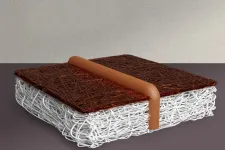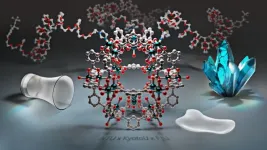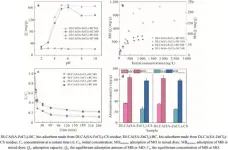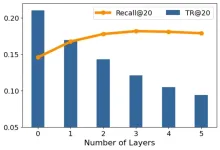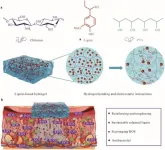(Press-News.org) As the world struggles to reduce greenhouse gas emissions, researchers are seeking practical, economical ways to capture carbon dioxide and convert it into useful products, such as transportation fuels, chemical feedstocks, or even building materials. But so far, such attempts have struggled to reach economic viability.
New research by engineers at MIT could lead to rapid improvements in a variety of electrochemical systems that are under development to convert carbon dioxide into a valuable commodity. The team developed a new design for the electrodes used in these systems, which increases the efficiency of the conversion process.
The findings will be reported in the journal Nature Communications, in a paper by MIT doctoral student Simon Rufer, professor of mechanical engineering Kripa Varanasi, and three others.
“The CO2 problem is a big challenge for our times, and we are using all kinds of levers to solve and address this problem,” Varanasi says. It will be essential to find practical ways of removing the gas, he says, either from sources such as power plant emissions, or straight out of the air or the oceans. But then, once the CO2 has been removed, it has to go somewhere.
A wide variety of systems have been developed for converting that captured gas into a useful chemical product, Varanasi says. “It’s not that we can’t do it — we can do it. But the question is how can we make this efficient? How can we make this cost-effective?”
In the new study, the team focused on the electrochemical conversion of CO2 to ethylene, a widely used chemical that can be made into a variety of plastics as well as fuels, and which today is made from petroleum. But the approach they developed could also be applied to producing other high-value chemical products as well, including methane, methanol, carbon monoxide, and others, the researchers say.
Currently, ethylene sells for about $1,000 per ton, so the goal is to be able to meet or beat that price. The electrochemical process that converts CO2 into ethylene involves a water-based solution and a catalyst material, which come into contact along with an electric current in a device called a gas diffusion electrode.
There are two competing characteristics of the gas diffusion electrode materials that affect their performance: They must be good electrical conductors so that the current that drives the process doesn’t get wasted through resistance heating, but they must also be “hydrophobic,” or water repelling, so the water-based electrolyte solution doesn’t leak through and interfere with the reactions taking place at the electrode surface.
Unfortunately, it’s a tradeoff. Improving the conductivity reduces the hydrophobicity, and vice versa. Varanasi and his team set out to see if they could find a way around that conflict, and after many months of trying, they did just that.
The solution, devised by Rufer and Varanasi, is elegant in its simplicity. They used a plastic material, PTFE (essentially Teflon), that has been known to have good hydrophobic properties. However, PTFE’s lack of conductivity means that electrons must travel through a very thin catalyst layer, leading to significant voltage drop with distance. To overcome this limitation, the researchers wove a series of conductive copper wires through the very thin sheet of the PTFE.
“This work really addressed this challenge, as we can now get both conductivity and hydrophobicity,” Varanasi says.
Research on potential carbon conversion systems tends to be done on very small, lab-scale samples, typically less than 1-inch (2.5-centimeter) squares. To demonstrate the potential for scaling up, Varanasi’s team produced a sheet 10 times larger in area and demonstrated its effective performance.
To get to that point, they had to do some basic tests that had apparently never been done before, running tests under identical conditions but using electrodes of different sizes to analyze the relationship between conductivity and electrode size. They found that conductivity dropped off dramatically with size, which would mean much more energy, and thus cost, would be needed to drive the reaction.
“That’s exactly what we would expect, but it was something that nobody had really dedicatedly investigated before,” Rufer says. In addition, the larger sizes produced more unwanted chemical byproducts besides the intended ethylene.
Real-world industrial applications would require electrodes that are perhaps 100 times larger than the lab versions, so adding the conductive wires will be necessary for making such systems practical, the researchers say. They also developed a model which captures the spatial variability in voltage and product distribution on electrodes due to ohmic losses. The model along with the experimental data they collected enabled them to calculate the optimal spacing for conductive wires to counteract the drop off in conductivity.
In effect, by weaving the wire through the material, the material is divided into smaller subsections determined by the spacing of the wires. “We split it into a bunch of little subsegments, each of which is effectively a smaller electrode,” Rufer says. “And as we’ve seen, small electrodes can work really well.”
Because the copper wire is so much more conductive than the PTFE material, it acts as a kind of superhighway for electrons passing through, bridging the areas where they are confined to the substrate and face greater resistance.
To demonstrate that their system is robust, the researchers ran a test electrode for 75 hours continuously, with little change in performance. Overall, Rufer says, their system “is the first PTFE-based electrode which has gone beyond the lab scale on the order of 5 centimeters or smaller. It’s the first work that has progressed into a much larger scale and has done so without sacrificing efficiency.”
The weaving process for incorporating the wire can be easily integrated into existing manufacturing processes, even in a large-scale roll-to-roll process, he adds.
“Our approach is very powerful because it doesn’t have anything to do with the actual catalyst being used,” Rufer says. “You can sew this micrometric copper wire into any gas diffusion electrode you want, independent of catalyst morphology or chemistry. So, this approach can be used to scale anybody’s electrode.”
“Given that we will need to process gigatons of CO2 annually to combat the CO2 challenge, we really need to think about solutions that can scale,” Varanasi says. “Starting with this mindset enables us to identify critical bottlenecks and develop innovative approaches that can make a meaningful impact in solving the problem. Our hierarchically conductive electrode is a result of such thinking."
The research team included MIT graduate students Michael Nitzsche and Sanjay Garimella, as well as Jack Lake PhD ’23. The work was supported by Shell, through the MIT Energy Initiative.
###
Written by David L. Chandler, MIT News
END
MIT engineers make converting CO2 into useful products more practical
A new electrode design boosts the efficiency of electrochemical reactions that turn carbon dioxide into ethylene and other products.
2024-11-13
ELSE PRESS RELEASES FROM THIS DATE:
Primary care professionals key to helping people achieve & maintain heart health
2024-11-13
Statement Highlights:
A new scientific statement outlines the role of primary care professionals in helping their patients achieve Life’s Essential 8, the key measures for improving and maintaining cardiovascular health defined by the American Heart Association.
The new statement highlights how primary care clinicians can help patients follow and maintain the Association’s Life’s Essential 8 health metrics for optimal cardiovascular health, which includes four health behaviors (diet, physical activity, nicotine exposure and sleep) and four health ...
Early detection, intensive treatment critical for high-risk patients with Kawasaki Disease
2024-11-13
Embargoed until 4:00 a.m. CT/5:00 a.m. ET Wed., Nov. 13, 2024
DALLAS, Nov. 13, 2024 — Advances in cardiac imaging techniques and risk categorization have led to improvements in diagnosis, initial treatment and long-term management of patients with Kawasaki Disease, according to a new scientific statement published today in the American Heart Association’s flagship, peer-reviewed journal Circulation.
The new statement, “Update on Diagnosis and Management of Kawasaki Disease,” summarizes the data published since the 2017 American Heart Association Scientific Statement ...
A phase-transformable membrane for efficient gas separation could revolutionize industrial applications
2024-11-13
Industrial gas separation, essential for clean energy and environmental protection, demands efficiency and adaptability. Current materials, however, lack the flexibility to selectively separate gases like carbon dioxide (CO₂) and hydrogen (H₂) while remaining energy-efficient. Researchers at the Institute for Integrated Cell-Material Sciences (WPI-iCeMS) at Kyoto University and the Department of Chemical Engineering at National Taiwan University have developed a phase-transformable membrane that could meet these needs.
This innovative membrane design relies on a unique combination of metal-organic polyhedra (MOP) with polyethylene glycol (PEG) chains. “Traditional ...
From camera to lab: Dr. Etienne Sibille transforms brain aging and depression research
2024-11-13
Toronto, Canada, November 13, 2024 - In science, the most fascinating breakthroughs often come from unexpected places. For Dr. Etienne Sibille, professor at the University of Toronto, and director of the Neurobiology of Depression and Aging program at CAMH, and co-founder and Chief Scientific Officer of Damona Pharmaceuticals, the path to revolutionizing mental health treatment began not in a laboratory, but through a camera lens in New York City.
"I grew up in France and went to medical school, but it was not for me. I was too restless and moved to ...
Depression rates in LGBTQIA+ students are three times higher than their peers, new research suggests
2024-11-13
The findings, which were published in the Journal of American College Health, uncover an alarming rise in depression rates among all higher education students in the United States, but especially among sexual and gender minorities. This population includes those who identified as lesbian, gay, bisexual, transgender, queer, questioning, intersex, asexual (LGBTQIA+), non-binary or gender non-conforming, and other identities.
“This study highlights the critical need for targeted interventions to support the mental health and well-being ...
Most parents don’t ask about firearms in the homes their kids visit
2024-11-13
Over 60 percent of Illinois parents had never asked another parent about an unlocked firearm in their home before allowing their child to visit for a playdate, according to a survey from Ann & Robert H. Lurie Children’s Hospital of Chicago published in Pediatrics. Many parents reported they had not asked about firearms because it never occurred to them to do so, which highlights a critical need to raise awareness of this important safety concern.
Among children 0-14 years old, almost 20 percent of unintentional firearm-related deaths occur at a friend’s home. ...
Beer-only drinkers’ diets are worse than wine drinkers
2024-11-13
SAN DIEGO, California (Nov. 13, 2024) — Beer drinkers have lower-quality diets, are less active, and are more likely to smoke cigarettes than people who drink wine, liquor, or a combination, according to a study scheduled for presentation at The Liver Meeting, held by the American Association for the Study of Liver Diseases.
“Alcohol overuse is the leading cause of cirrhosis in the U.S., and metabolic dysfunction-associated steatotic liver disease (MASLD) is rapidly increasing,” said Madeline Novack, chief resident at Tulane School of Medicine’s internal medicine residency program and lead author of the study. “Both ...
Eco-friendly biomass pretreatment method yields efficient biofuels and adsorbents
2024-11-13
As global demand for sustainable energy solutions increases, bioethanol production from lignocellulosic biomass is gaining traction. However, traditional methods face limitations due to high processing costs and waste issues. A recent study led by Xinchuan Yuan, published in the Journal of Bioresources and Bioproducts, presents an innovative biomass pretreatment method that not only improves bioethanol production efficiency but also utilizes biomass residues as bio-adsorbents for wastewater treatment, potentially transforming the industry.
Producing ...
How graph convolutions amplify popularity bias for recommendation?
2024-11-13
Graph convolutional networks (GCNs) have become prevalent in recommender system (RS) due to their superiority in modeling collaborative patterns. Although improving the overall accuracy, GCNs unfortunately amplify popularity bias --- tail items are less likely to be recommended. This effect prevents the GCN-based RS from making precise and fair recommendations, decreasing the effectiveness of recommender systems in the long run.
Performance change of LightGCN with different graph convolution layers on Gowalla. Recall@20 and TR@20 ...
New lignin-based hydrogel breakthrough for wound healing and controlled drug release
2024-11-13
As the demand for advanced wound healing and drug delivery materials grows, scientists are turning to sustainable, bioactive materials for innovative solutions. A recent study by Bowei Wang et al., published in the Journal of Bioresources and Bioproducts, presents a breakthrough in lignin-based hydrogels designed to combine mechanical strength with bioactivity. This research reveals a controlled-release polyvinyl alcohol (PVA) and chitosan (CS) hydrogel, augmented with sulfonated lignin, which could revolutionize the treatment of complex wounds and enable sustained drug ...
LAST 30 PRESS RELEASES:
Interaction of climate change and human activity and its impact on plant diversity in Qinghai-Tibet plateau
From addressing uncertainty to national strategy: an interpretation of Professor Lim Siong Guan’s views
Clinical trials on AI language model use in digestive healthcare
Scientists improve robotic visual–inertial trajectory localization accuracy using cross-modal interaction and selection techniques
Correlation between cancer cachexia and immune-related adverse events in HCC
Human adipose tissue: a new source for functional organoids
Metro lines double as freight highways during off-peak hours, Beijing study shows
Biomedical functions and applications of nanomaterials in tumor diagnosis and treatment: perspectives from ophthalmic oncology
3D imaging unveils how passivation improves perovskite solar cell performance
Enriching framework Al sites in 8-membered rings of Cu-SSZ-39 zeolite to enhance low-temperature ammonia selective catalytic reduction performance
AI-powered RNA drug development: a new frontier in therapeutics
Decoupling the HOR enhancement on PtRu: Dynamically matching interfacial water to reaction coordinates
Sulfur isn’t poisonous when it synergistically acts with phosphine in olefins hydroformylation
URI researchers uncover molecular mechanisms behind speciation in corals
Chitin based carbon aerogel offers a cleaner way to store thermal energy
Tracing hidden sources of nitrate pollution in rapidly changing rural urban landscapes
Viruses on plastic pollution may quietly accelerate the spread of antibiotic resistance
Three UH Rainbow Babies & Children’s faculty elected to prestigious American Pediatric Society
Tunnel resilience models unveiled to aid post-earthquake recovery
Satellite communication systems: the future of 5G/6G connectivity
Space computing power networks: a new frontier for satellite technologies
Experiments advance potential of protein that makes hydrogen sulfide as a therapeutic target for Alzheimer’s disease
Examining private equity’s role in fertility care
Current Molecular Pharmacology achieves a landmark: real-time CiteScore advances to 7.2
Skeletal muscle epigenetic clocks developed using postmortem tissue from an Asian population
Estimating unemployment rates with social media data
Climate policies can backfire by eroding “green” values, study finds
Too much screen time too soon? A*STAR study links infant screen exposure to brain changes and teen anxiety
Global psychiatry mourns Professor Dan Stein, visionary who transformed mental health science across Africa and beyond
KIST develops eco-friendly palladium recovery technology to safeguard resource security
[Press-News.org] MIT engineers make converting CO2 into useful products more practicalA new electrode design boosts the efficiency of electrochemical reactions that turn carbon dioxide into ethylene and other products.
